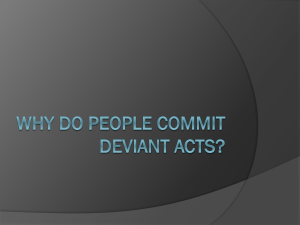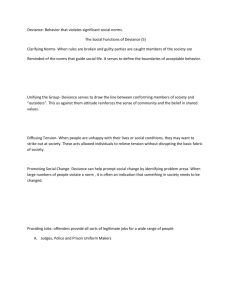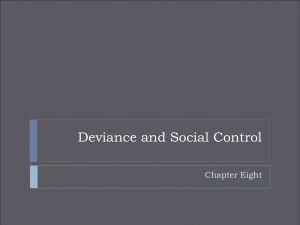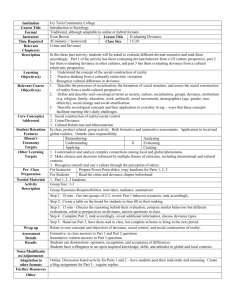DOC - Queens College
advertisement
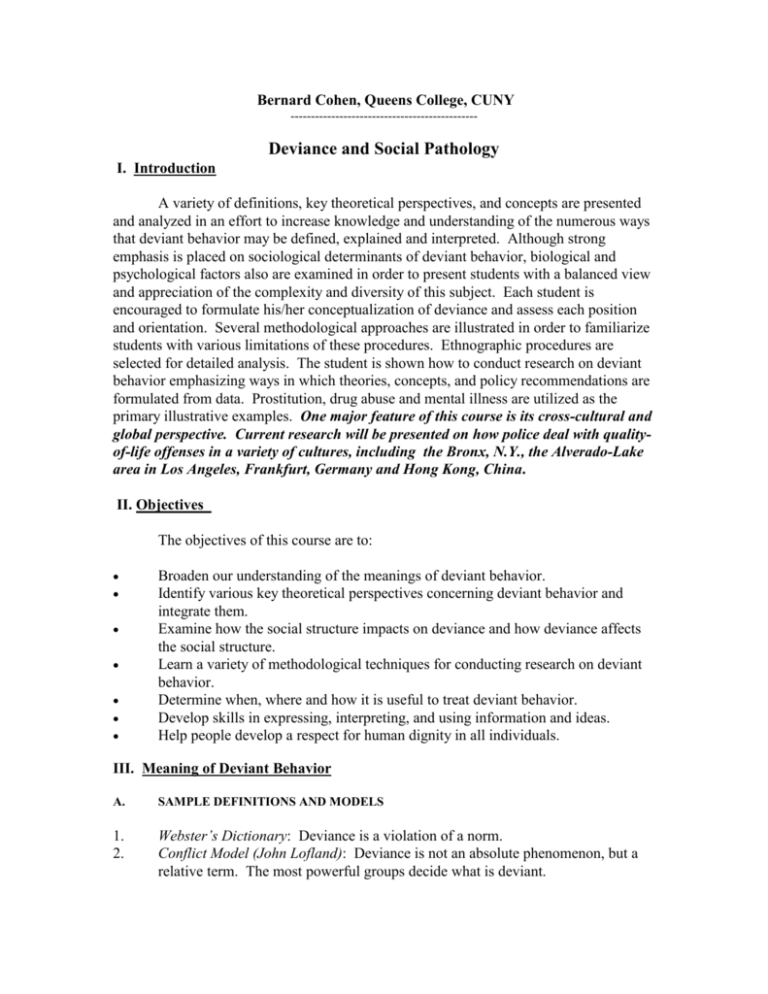
Bernard Cohen, Queens College, CUNY ---------------------------------------------- Deviance and Social Pathology I. Introduction A variety of definitions, key theoretical perspectives, and concepts are presented and analyzed in an effort to increase knowledge and understanding of the numerous ways that deviant behavior may be defined, explained and interpreted. Although strong emphasis is placed on sociological determinants of deviant behavior, biological and psychological factors also are examined in order to present students with a balanced view and appreciation of the complexity and diversity of this subject. Each student is encouraged to formulate his/her conceptualization of deviance and assess each position and orientation. Several methodological approaches are illustrated in order to familiarize students with various limitations of these procedures. Ethnographic procedures are selected for detailed analysis. The student is shown how to conduct research on deviant behavior emphasizing ways in which theories, concepts, and policy recommendations are formulated from data. Prostitution, drug abuse and mental illness are utilized as the primary illustrative examples. One major feature of this course is its cross-cultural and global perspective. Current research will be presented on how police deal with qualityof-life offenses in a variety of cultures, including the Bronx, N.Y., the Alverado-Lake area in Los Angeles, Frankfurt, Germany and Hong Kong, China. II. Objectives The objectives of this course are to: Broaden our understanding of the meanings of deviant behavior. Identify various key theoretical perspectives concerning deviant behavior and integrate them. Examine how the social structure impacts on deviance and how deviance affects the social structure. Learn a variety of methodological techniques for conducting research on deviant behavior. Determine when, where and how it is useful to treat deviant behavior. Develop skills in expressing, interpreting, and using information and ideas. Help people develop a respect for human dignity in all individuals. III. Meaning of Deviant Behavior A. SAMPLE DEFINITIONS AND MODELS 1. 2. Webster’s Dictionary: Deviance is a violation of a norm. Conflict Model (John Lofland): Deviance is not an absolute phenomenon, but a relative term. The most powerful groups decide what is deviant. BERNARD COHEN, QUEENS COLLEGE, CUNY 3. 4. 5. 6. 7. Consensus Model (Talcott Parsons): There is a majority consensus in society of what constitutes deviance. Thus, deviance is deemed as any kind of behavior that will disrupt the functioning of society. Labelling (Howard Becker): Deviance is any behavior that people so label. Reaction-Intervention (Edwin Schur): Human behavior is deviant to the extent that it comes to be viewed as a personally discreditable departure from a group’s normative expectations and this departure elicits interpersonal or collective reactions that serve to isolate, treat, correct or punish individuals engaged in such behavior. A distinction is made between the terms “discreditable” and “discredited” (Erving Goffman). High and Low Consensus Deviance (Alexander Thio): In this model, behaviors declared deviant are placed on a continuum. Those acts which the majority of the population judge as deviant are placed at the upper or high end of the continuum (e.g., cheating on an exam). Deviance as a Sensitizing Concept (Herbert Blumer): Behaviors deemed deviant can rarely be defined with precision. Such behaviors only serve to sensitize the group as to what is considered deviant. B. PARADIGMS FOR CLASSIFICATION 1. Robert Merton’s paradigm of crime and deviance categorizes five types of behavior: Predatory acts, mala prohibita, law-abiding deviance, normative acts and mala in se, when not illegal. Bernard Cohen’s paradigm of crime and deviance makes a distinction between norm violations and norm violators and between intrinsic and extrinsic deviance. Crime and Deviance (Edward Sagarin): (a) Crime and deviance are equivalent; (b) crime and deviance are two distinct phenomena; (c) crime is the generic or global conceptual term and deviance is a part; (d) deviance is the generic or global term and crime is absorbed in deviance; and (e) crime and deviance overlap at some but not all points. Parameters of Deviance (Bernard Cohen): These include: (a) violation of a norm; (b) elicitation of a negative response; (c) visibility; (d) seriousness; (e) frequency; and (f) degree of disclosure. Progressive Stages of Deviance; experimental, primary and secondary deviance (Edwin Lemert): The experimental stage of deviance is characterized by a superficial engagement in deviant behavior. During primary deviance, the deviant behavior which began on a sporadic basis steadily increases. During secondary deviance the individual assumes the role, self-concept and lifestyle of a deviant. Key distinctions between experimental, primary and secondary deviance are discussed. Also, the sequence of interaction leading to secondary deviation is examined. 2. 3. 4. 5. BERNARD COHEN, QUEENS COLLEGE, CUNY C. STUDY AIDS 1. Film: “Radical Sex Styles.” This film presents six scenarios of unusual sexual adaptations. It provides the student with an opportunity to apply the various definitions, models, and classifications of deviant behavior. Small Group Project: (a) Apply the parameters of deviance, the concepts of primary and secondary deviance, the eight-step sequence, the consensus model, and the conflict model to: call girls, street prostitutes, and white collar offenders. (b) Formulate new behaviors which are marginal and decide whether or not they are deviant. 2. IV. Theoretical Perspectives on Deviant Behavior The determinants of deviant behavior are multiple and diverse. Although recognizing the importance of biological and psychological determinants of deviance, the focal point of discussion is on the sociological perspective. The strengths and weaknesses of each perspective are explored. A. SELECTED ISSUES Cultural Determinism vs. Biological Determinants: An examination of the nature vs. nurture question. Absolute vs. Relativism: Which deviant behaviors may be perceived as absolute and/or relative. Grand Range Theory vs. Middle Range Theory: Selected perspective for specific behaviors. Functionalism: Is deviance functional? (Illustrations: Emile Durkheim, Robert Merton, and Kingsley Davis.) B. THEORETICAL PERSPECTIVES 1. Labelling and the Medical Model a. Labelling Perspective: Key concepts related to this theoretical perspective include stigma, self-concept, self-fulfilling prophecy, rejection, role, subculture, master status, subordinate status, and moral entrepreneur. b. Medical Model: (1) The medical model of mental illness, advocated by many psychiatrists and psychologists, views the individual as physically or mentally ill and in need of early and accurate diagnosis followed by prompt therapeutic intervention. (2) Opponents of the medical model and the labelling of individuals as “mentally ill” include Thomas Scheff, Edward Sagarin, R.D. Lang, and Thomas Szasz. (3) Thomas Scheff, for example, has suggested that the concept of “residual deviance” be BERNARD COHEN, QUEENS COLLEGE, CUNY employed in the place of “mental illness.” He denotes nine propositions regarding the labelling of these individuals. (4) Edward Sagarin has argued that the label of mental illness is used to deprive individuals of their constitutional rights. He cites several abuses which affect the “mentally ill” person. (5) The legal issue of insanity and the plea of “innocent by reason of insanity” are discussed. Most states utilize two rules for the insanity issue: (a) M’Naughten Rule: Did the person know the difference between right and wrong? (b) Durham Rule: “irresistable impulse” and/or has a history of mental illness. (6) Study Aids, Films: (a) “Harry” --a film dealing with a mildly retarded individual who is being treated by behavior modification techniques for self-abusive behaviors and reliance on restraints. (b) “Titticutt Follies” -- film depicts institutionalized “treatment”of the mentally ill. 2. Theory of Anomie (Robert K. Merton) According to Merton, whose theory is grounded in the functionalist perspective, deviance is a result of alienation. Because of an imbalance in the structure of society, individuals are blocked from achieving the goals set by society. In American society, for example, although there is the notion of equality, a stratification system exists. Thus, individuals in the lower class who are unable to gain access to the institutionalized means of achieving cultural goals may use illegal means instead. This theory helps explain the determinants of deviance for profit (e.g., prostitution and armed robbery) and drug abuse. 3. Theory of Deviant Subcultures (Marvin Wolfgang; Albert K. Cohen) According to this theory, social interaction with certain types of groups that engage in forms of deviance may lead to adoption of, or an increase in, deviant behavior. Deviance that may be determined by interaction within a subgroup include prostitution, alcoholism, drug addiction, transvestism, and gang delinquency. 4. Labelling Theory, continued (Howard Becker) In addition to mental illness, this theory is also a useful theoretical perspective in understanding sexual deviance and deviance for profit. 5. Multiple-Problem Situation (Walter Reckless) According to this position, the probability of deviance increases when an individual experiences numerous problems (e.g., broken home, unemployment, poor education, emotional disorders, etc.). Control theory is also discussed. BERNARD COHEN, QUEENS COLLEGE, CUNY 6. Culture-Conflict Approach (Thorsten Sellin) This approach argues that when individuals immigrate from other countries, their culture of origin may conflict with the American culture and result in deviant behavior. 7. Conflict Theory (Richard Quinney) This theory, based on the conflict or Marxist, approach asserts that the capitalist structure is to blame for American society’s ills. Quinney’s six propositions of his theory, “the social reality of crime,” are discussed. 8. Techniques of Neutralization: Theory of Delinquency (G. Sykes and D. Matza) According to this theory, individuals become delinquent because they cross the Thin line separating legitimate from illegitimate behavior. They neutralize or rationalize their behavior in several ways including denial of responsibility, denial of injury, denial of the victim, condemnation of those who condemn them, and appeal to higher loyalties. 9. Symbolic Interaction (Herbert Blumer) a. Definition and major issues, e.g., conforming behavior and deviant behavior are not absolutes but are consistently redefined; formal laws constitute guidelines but only guidelines for the interactional processes; on-going processes of negotiation between agents of social control. b. Herbert Mead, Edwin Lemert, Herbert Blumer: Key Concepts. c. Study Aids: Film and photographs on drug abuse. “Skezag”-- film about drug addicts provides an opportunity to examine the various theoretical perspectives on behavior. 10. Feminist Theory (Kathleen Daly and Meda Chesney-Lind) These theories explain deviance and agencies of control by focusing on gender, sex roles and a patriarchal structure that permeates all aspects of the social system. 11. Deviance Control: Theory and Practice (James Wilson and Richard Herrnstein) Severity, certainty, and celerity of punishment, time horizons, time discounting, rational choice, operant conditioning, routine activities, and “cause-removal,” are examined. 12. Integrated Theory (Terence P. Thornberry) An attempt to reengineer individual perspectives on deviant behavior into a cohesive synchronized theory. Advantages and disadvantages of theoretical integration are discussed. BERNARD COHEN, QUEENS COLLEGE, CUNY V. How to Conduct Research on Deviant Behavior A. METHODOLOGICAL APPROACHES: QUALITATIVE, QUANTITATIVE, AND ETHNOMETRICS Emphasis is on qualitative methods of research including field study, selective participant observation, and interviews; as well as the use of quantitative methods such as official statistical data, statistical analysis, and sampling. The technique of ethnometrics, which combines qualitative and quantitative methods, is illustrated. A major feature of this course is its cross-cultural and global perspective. Current research will be presented on how police deal with quality-of-life offenses in a variety of cultures, including the Bronx, N.Y., the Alverado-Lake area in Los Angeles, Frankfurt, Germany and Hong Kong, China. B. Ethical Issues A presentation of the ethical issues which arise in conducting research are explored including whether physical, psychological, social, or any other form of harm may come to human subjects as a result of the study; “whether the researcher’s identity” should be disclosed to the subjects; “and whether human subjects” should be given information regarding “the nature of the research.” The concept of “informed consent” is analyzed. Selected Readings (Note: Readings must be completed when the subject is presented in class.) Textbook: Sociology of Deviant Behavior (13th ed.), Marshall Clinard andRobert Meier, US: Thompson/Wadsworth, 2008, and /or selections from: 1. 2. 3. 4. 5. Asylums: Essays on the Social Situation of Mental Patients. Erving Goffman, Garden City, NY: Anchor Books, 1961. Pp.171-321 on the medical model. Crime and Human Nature. James Q. Wilson and Richard Herrnstein, N.Y: Simon & Schuster, Inc., 1985. Chapters 1 and 2 on theory and chapter 15 on altering behavior. The Outsiders, Howard Becker, NY: The Free Press, 1963. Chapters 1 and 2 on definitions of deviance, and chapter 8 on theoretical perspectives. Theories of Deviance. 4th ed. Stuart H. Traub and Craig B. Little (eds.), Itasca, IL: Peacock, 1994. Select one theory of deviance from each of the six sections on theoretical perspectives. “Towards an Interactional Theory of Delinquency.” Terence P. Thornberry, Criminology, 25:863-891 on integrated theory. Requirements: examinations. The requirements for this course include several multiple-choice type


